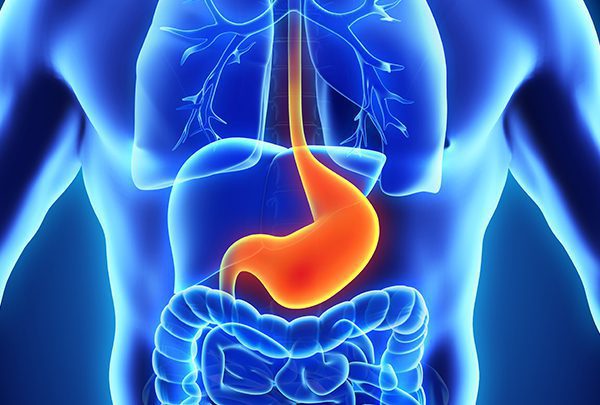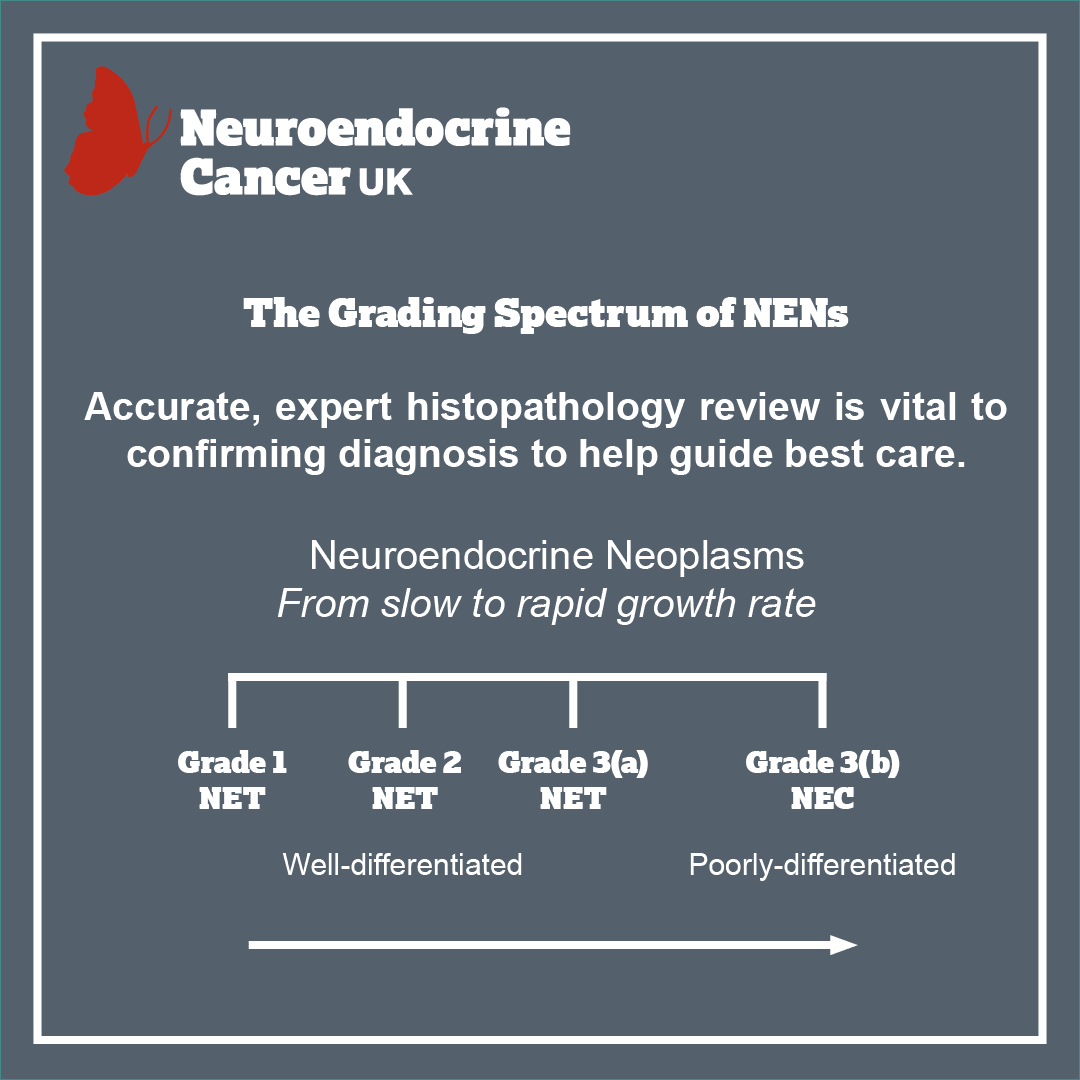NEUROENDOCRINE CANCER OF THE
DUODENUM
The Facts
Neuroendocrine Neoplasm (NENs) is an umbrella term used to cover a group of cancers that start in neuroendocrine cells. These cancers may also be referred to as NETs, NECs, or even Carcinoids. NENs occur when neuroendocrine cells stop working normally and start to grow or behave abnormally.
There are 2 key types of NEN:
- NETs (neuroendocrine tumours) are called ‘well-differentiated’ and tend to have a slow to moderate growth pattern.
- NECs (neuroendocrine carcinomas) – are called ‘poorly differentiated’ and tend to grow rapidly.
To simplify, we use the term NENs throughout this page.
Duodenal NENs
The duodenum is the short tube that connects the stomach to the rest of the small bowel (small intestine). It is here that semi-digested food and stomach acid (chyme) is ‘processed’ so that nutrients can be absorbed as it passes through towards the large bowel. Key nutrients absorbed in the duodenum include iron, vitamins A and B1, calcium and other nutrients.
In Duodenal NENs you may hear the terms “Functioning” (meaning “with hormone related symptoms”) or “Non-functioning” (meaning “without hormone related symptoms”).
Many Duodenal NENs are non-functioning. Symptoms, if or when they occur, tend to be related to the size and, or position of the NEN and can include back pain, jaundice, stomach pain, nausea, vomiting and, or weight loss. Functioning Duodenal NENs can produce syndromes – due to producing too much of a specific hormone. These include: Gastrinoma (Zollinger-Ellison syndrome) and Somatostatinoma. A very small percentage may also produce symptoms of Carcinoid Syndrome.
Symptoms
Symptoms that may or may not include Neuroendocrine Cancer associated syndromes. (Syndrome is where 2 or more related symptoms occur).
In Duodenal Neuroendocrine Cancer – you may hear the terms “Functioning” (meaning “with hormone related symptoms”) or “Non-functioning” (meaning “without hormone related symptoms”). Nb. Functioning or non-functioning may also be terms used to describe whether these cancers show up on nuclear medicine imaging* (see diagnostic tests).
Many of Neuroendocrine Cancers of the Duodenum are non-functioning, meaning that they do not over produce hormones. Symptoms, if/when they occur, tend to be related to the size and / or position of the cancer and can include back pain, jaundice, stomach pain, nausea, vomiting and / or weight loss.
Functioning Duodenal Neuroendocrine Cancers can produce syndromes – due to producing too much of specific hormone. These include:
- Gastrinoma (Gastrin): Zollinger-Ellison syndrome – acid reflux, heartburn, burping, stomach/chest pain, diarrhoea, anaemia
- Somatostatinoma (Somatostatin): can cause symptoms of diabetes – like feeling tired, going pee a lot, dry mouth, nausea, weight loss and anaemia. They may also cause diarrhoea and / or steatorrhoea (fatty pale stools).
A very small percentage may also produce symptoms of Carcinoid Syndrome: dry flushing of face and torso but can occur over whole body, palpitations, headache and blood pressure alterations, diarrhoea, asthmatic-like wheezing, weight loss or gain, malnutrition and / or fatigue.
Other, rarer symptoms, including Paraneoplastic syndrome and oncological emergencies, (a specific set of health concerns that can occur in any cancer), such as raised calcium levels (Hypercalcaemia), may occur.
Further information about Neuroendocrine Cancer associated and Paraneoplastic Syndromes – including Oncological emergencies – can be found here.
Tests
Tests that may be used for the diagnosis and / or monitoring of Neuroendocrine Cancer of the Duodenum:
Blood and / or urine:
Full blood count
Liver and kidney function
B12/Iron/Ferritin/Folate
Chromogranin A
Urinary or serum 5HiAA (serotonin)
Gut hormone profile
Thyroid function
LDH
MEN1 screen
Consider Genetic testing ( eg MEN1, VHL, etc).
Scans:
CT chest, abdomen and pelvis and/ or CT chest & MRI abdomen and pelvis
Octreotide (SPECT) or Gallium-Dotatate PET/CT.
FDG-PET – if NEC or rapidly progressive disease seen or suspected.
Endoscopy:
Upper endoscopy – OGD +/- biopsy
Endoscopic Ultrasound (EUS) +/- biopsy
Pathology (what can be seen through special tests under a microscope):
Differentiation and cellular morphology
Synaptophysin
Chromogranin
Ki67
Gut hormone (optional) – even in absence of neuroendocrine associated syndrome
SSTR2a (optional).

Grading
Not all cancers are the same or behave in the same way. Some may grow very slowly, may not have invaded nearby structures, or spread to other parts of the body at the time of diagnosis – but they have the potential to. However some may have already spread at the time of diagnosis. The grade is the rate at which the NEN grows. You might see this referred to as ‘Ki67’ or ‘Mitotic Index’ mentioned in your clinic letters or medical reports. Grade 1 is slow-growing through to Grade 3, a more aggressive, rapidly growing disease.


Causes and / or risk factors
We do not know exactly what causes NENs, however research is ongoing to truly understand both the pathology and the biology with the hope that this will lead to a much better understanding of the causes.
Most NENs do not run in families; however, there are a number of rare conditions that may increase your risk. Therefore, if other members of the family have been diagnosed with a particular cancer (especially aged 50 years or less) or cancer-associated genetic condition, it is important that you tell your specialist team about not only your medical history, but also any family medical illnesses or conditions.

So how is it treated?
The key aim of treatment, should be to help you have the best possible care and quality of life, by ensuring access to appropriate treatment, management of symptoms and addressing what’s most important to you.
Treatment options include:
- Surgery
- Somatostatin analogues (SSAs)
- Chemotherapy
- Targeted Molecular Therapies
- Peptide receptor radionuclide therapy (PRRT)
- Radiotherapy
- Endoscopic procedure
- Interventional radiology
- Endoscopic procedure
- Irreversible electroporation (IRE also known as Nanoknife)
- Clinical Trials
- Symptom Control
- Surveillance – can be used to assess how well treatment is working or in periods between treatments (which may be months/ years). Visit our website for explanations on all treatments available in the UK.


Follow up
There are expert agreed guidelines regarding how and when follow up should occur, however, in practice this varies and often with good reason. Follow up should be expert informed & evidence /research based but also tailored to you and what is appropriate for your best care.
For patients with Grade 1 – 2 NET – who have had a complete (R0) or incomplete (R1) resection:
- 3 – 9 monthly CT or MRI and biochemistry (type depending on pre-operative results) – extend interval as per stability of disease
- Endoscopic surveillance 12-24 months
- Functional imaging 18 – 24 months.
For Grade 3 NET/NEC:
- Resected disease – Contrast CT scan every 3 – 6 months for 2 – 3 years, and then every 6 – 12 months
- Residual / Advanced disease – Contrast CT scan every 2 – 3 months if on therapy
- Endoscopic surveillance : as clinically indicated – 6 – 12 months
- Functional imaging 18 – 24 months – or earlier if progression suspected
Biochemistry if elevated at diagnosis.
Advanced disease: follow up as per guidelines – but should be guided by prognosis, expected treatment efficacy and treatment related toxicity. Your health, well-being, physical activity, informed choice and preference for ongoing care as well as aim of treatment should be reviewed and discussed to best plan care.

